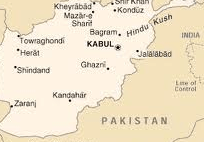The LA Times has released a series of photos showing US (and Afghan) soldiers posing with the body of a dead Taliban suicide bomber. Like most cases of misconduct by US soldiers — like the Marine urination video — there’s outrage and concern. But in this case, the outrage will be more in the US and in the American media, not in Afghanistan.
Here are a few initial thoughts as to why:
– Afghans face bigger concerns in their daily life than a few pictures of US soldiers with dead insurgents, for whom there is little sympathy anyway. Concerns about the daily bread and survival, about girls returning home from school without being poisoned or harassed, about navigating the corrupt bureaucracy, etc. far outweigh the photos in a US publication.
-…which most Afghans will never get to see anyway, because most of them don’t have TVs and those who do, don’t have the electricity to run it. Only about 5 percent of the population has internet access. However, most Afghans have radios, so how the story is covered will matter; but judging by previous reporting of similar stories, radio coverage won’t really change anything and it won’t be much different from coverage on TV.
-The photos are, more than anything, about the United States, its (rightful) concerns about the troops’ professional conduct and its obsession, as it would appear to Afghans, with trivial moral matters.
The bigger question that no one seems to focus on is the mentoring faux pas of US forces, who started the photo session as Afghan soldiers watched nearby. The Afghan soldiers were later included in the shoot.
An even bigger question is the systemic issues in the US military that continue to allow for humiliating and dehumanizing incidents to occur. Incidents such as the Haditha massacre, the Abu Ghraib prisoner abuse, the US soldiers’ Kill Team, the Marine urination video, the Daniel Chen case, the Kandahar massacre of villagers, the Quran burning, etc. point to systemic loose ends. Unfortunately, the US looks into each incident individually and has not yet indicated that it is taking the whole-of-the-system approach to tackle these incidents, which continue to occur at great cost to the the US and the communities where they happen.
